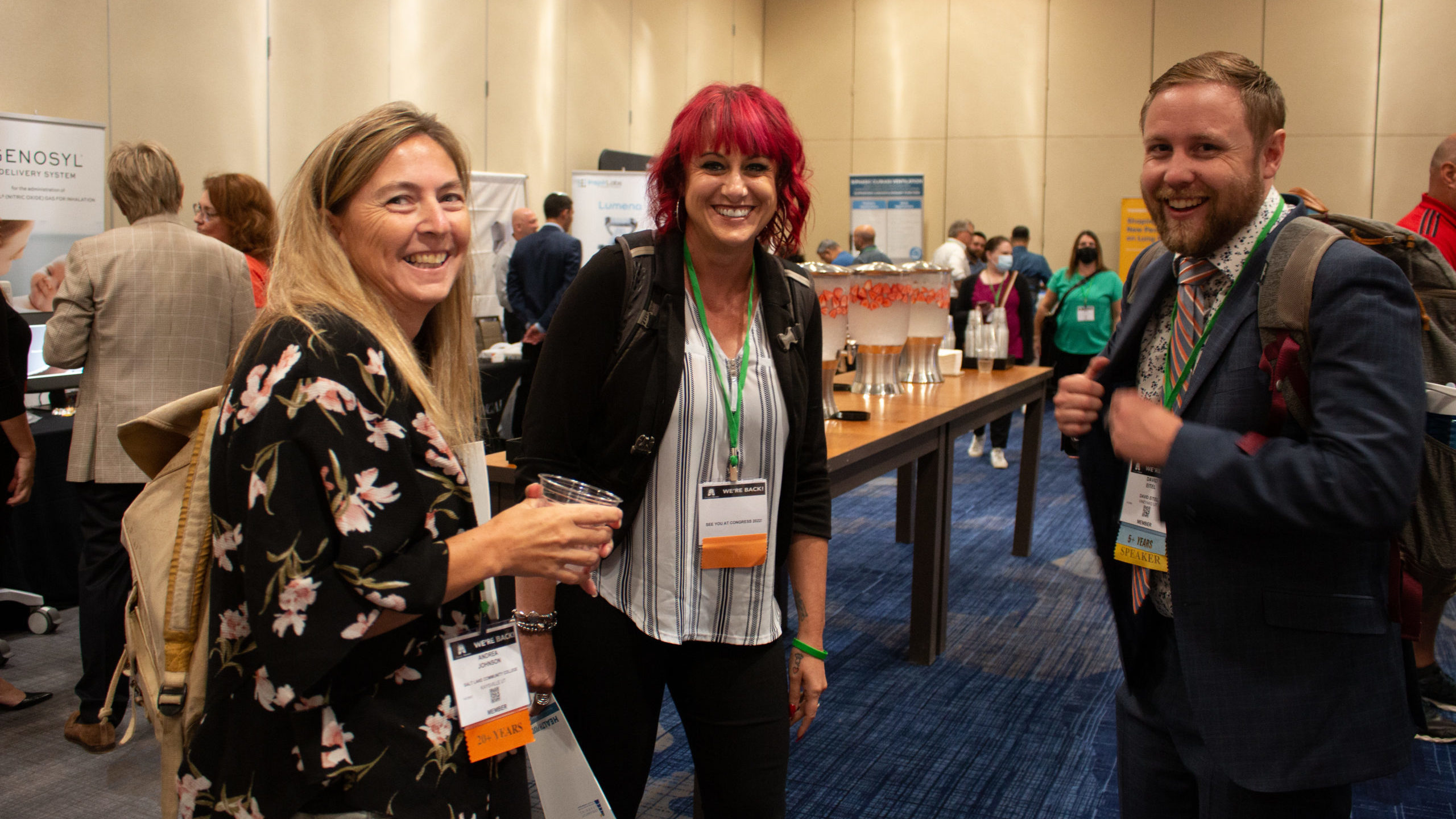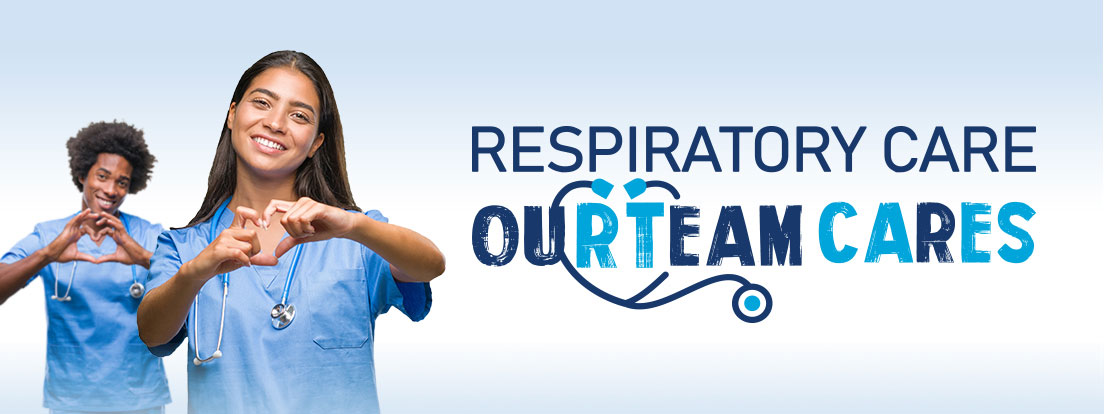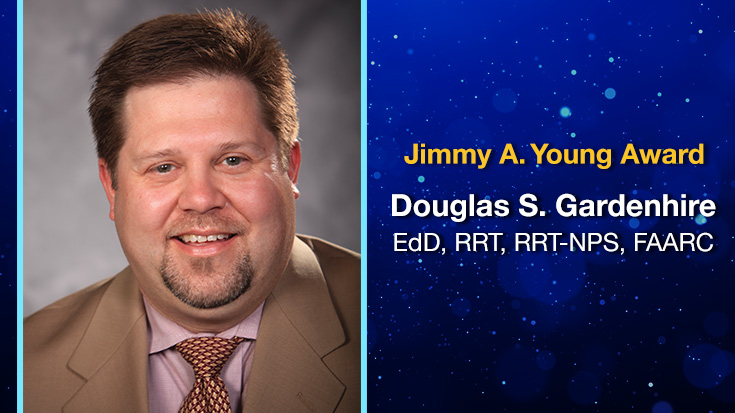
Honoring a Career Filled with Education, Scholarship, and Service
A lifelong sports fan, Douglas S. Gardenhire, EdD, RRT, RRT-NPS, FAARC, remembers getting cable TV back in the early 1980s in his hometown of Parsons, KS, and how it broadened both he and his dad’s opportunities to watch games from across the country.
“Going from turning the knob on the TV to three or four stations, we now had 25-plus,” he recalled. Despite their ongoing devotion to the Kansas City Chiefs and Kansas City Royals, they started tuning in to Atlanta Braves games on the newly acquired TBS as well and soon decided they’d root for them too.
Little did he know at the time, however, that he would end up having good reason to be a Braves fan. In fact, as chair of the department of respiratory therapy and a Governor’s Teaching Fellow at Georgia State University (GSU) in Atlanta, he’s had the opportunity to continue that childhood passion.
“I am sure this happened to many, but for me, 20 years later, to live and have a career in Atlanta and, because of cable TV, have a history with a team that you watched and cheered was like it was meant to occur,” he said.
Unfortunately for professional sports, Dr. Gardenhire didn’t fulfill his childhood dream of actually playing in the big leagues; however, fortunately for respiratory care, this year’s winner of the Jimmy A. Young Medal has definitely played in the big leagues of the profession.
Over the past nearly 30 years, he has contributed immensely in education, service, and scholarship.
First-hand look at RTs
While Dr. Gardenhire really wanted to be a professional athlete when he grew up, respiratory care entered his life early on as well, when severe allergies and asthma too often put him on the sidelines.
“When I was around five, they tested me for over 60 allergies,” he explained. “My back, arms, and legs had welts all over them.”
He was allergic to almost everything. Between his allergies and asthma, he was a regular visitor at the county hospital, receiving breathing treatments, oxygen, and the croup tent. Respiratory therapists were there to get him through it.
“I was sick all the time, having to stay in the hospital at least every year from three to 12 and receiving my rounds of breathing treatments from RTs,” he said. His health improved when he entered his teenage years, but he never forgot the care therapists gave him. Since he liked science and had fond memories of his treatment by RTs, he decided it would be the career for him too.
Dr. Gardenhire enrolled in the RT program at Labette Community College in 1991. At the same time, he took a job as an OJT/student tech at Labette County Medical Center, now known as Labette Health — the same hospital he had spent so much time in when he was younger.
“I was lucky because I was able to work with the same OJTs and RTs that cared for me when I was a kid,” he said.
He graduated in 1993 and earned his CRTT credential, then passed the RRT exams later that year. From there, he headed to Wichita to complete a BS degree in health science at Wichita State University while working full-time as a therapist at St. Joseph Hospital.
“I did everything the department would let me,” he said. In addition to working in the adult, pediatric, and neonatal ICUs, he took shifts in the PFT lab and sleep center. Most of his time, however, was spent in the surgical ICU.
One day, though, some colleagues in the department told him they would take a relatively new exam to earn the Neonatal-Pediatric Specialist (NPS) credential and convinced him to join them.
“I did and will never forget it,” he said.
He earned his BS degree in 1995 and was ready for a new challenge.
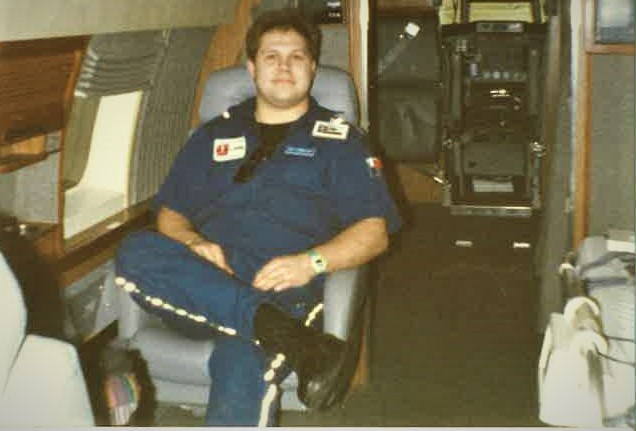 Dr. Gardenhire spent more than two years on an elite transport team in Birmingham, AL.
Dr. Gardenhire spent more than two years on an elite transport team in Birmingham, AL.“A colleague of mine told me about some friends doing international and domestic transport for the University of Alabama Hospitals in Birmingham,” he explained. “She told them about me, and the next thing I know, I am traveling around the country and world transporting patients.”
Transport proved to be just the challenge he was looking for.
“This was a great place to work and to use your knowledge and skills as an RT and a health care practitioner,” he said. “At 35,000 feet, it’s you, your experience, and your team member.”
On to the classroom
Dr. Gardenhire loved his time in clinical care and as a transport RT, but another passion eventually took precedence in his career. It is the one that has carried him beyond the day-to-day delivery of respiratory care into a position where he has been able to help shape future professionals.
“My first introduction to teaching was as an adjunct clinical instructor for the Wichita State University RT program when I worked at St. Joe,” he said. “I loved it.” So when he got an offer to come on board as director of clinical education at Labette Community College after two years on the transport team in Birmingham, he decided to head back to Kansas and give it a shot.
He brought his new wife with him, who hailed from Birmingham, and after a few years at Labette, began looking around for a faculty position that would take them both back to the south. That’s when he met one of his long-time mentors in the field, Joseph Rau, PhD, RRT, FAARC, now professor emeritus at GSU.
“My contact with Doug began in 2001 when I was serving as chair of the respiratory therapy department, and in that capacity led a search for a faculty member,” recalled Dr. Rau. ”Doug had a strong clinical background in transport and pediatric respiratory care and impressed the search committee with his technical and interpersonal skills. We were, fortunately, able to recruit him into the department, where he quickly showed himself to be an outstanding faculty member.”
Another long-time mentor, Lynda Goodfellow, EdD, RRT, FAARC, who now serves as director of clinical practice guidelines development at the AARC, was at GSU too back then and was Dr. Gardenhire’s supervisor when Dr. Rau retired in 2004.
“Doug strives to be a role model to his faculty and students,” she said. “He expects a lot from faculty and students, but he treats them all like they are part of his family. If there is a need, he will go out of his way to find resources.”
A daunting task
Dr. Goodfellow believes one of Dr. Gardenhire’s greatest contributions to the profession has come in his willingness to take over the helm of Dr. Rau’s long-running textbook on respiratory care pharmacology.
“When Dr. Rau approached me to take over the text, I turned him down, but after more discussion, I agreed,” said Dr. Gardenhire. “I think it has been the most important decision I have made in my career.”
The text, renamed “Rau’s Respiratory Care Pharmacology” in honor of its original author, is now in its tenth edition. Dr. Goodfellow remembers thinking what a daunting task Dr. Gardenhire was taking on when he agreed to author the seventh edition and was honored when he asked her to write the forward to the eighth.
“I struggled to find a way to connect Joe’s editions to Doug as this textbook was one of the first pharmacology texts for respiratory therapists,” she admitted. “I ended up comparing the differences between Joe’s first edition and Doug’s second. Joe’s first edition in 1978 was 149 pages, 14 chapters, no color or illustrations used, and the index was four pages. Doug’s second edition in 2012 had 23 chapters, 450 pages, color charts, graphs, figures, and tables. The index alone was 21 pages! It is still amazing to see how far this one textbook has changed over the past 40-plus years.”
As Dr. Gardenhire built a career for himself in the educational sector of respiratory care, he also continued to advance his education. He earned first a master’s of science in technical teacher education from Pittsburg State University in Pittsburg, KS, in 2000 and then his doctor of education from the University of Georgia in Athens in 2010.
His dissertation harkened back to his childhood love of sports and struggles with allergies and asthma: “Athletic Trainers’ Perception of Asthma.”
At GSU, he has been widely credited with further developing the respiratory care programs at GSU. As a result, GSU now offers both entry-level bachelor’s and master’s degrees for RT students and a degree advancement program for a master’s of science degree in respiratory care.
He has also conducted numerous research studies, presented multiple abstracts at the AARC Congress, and published papers in Respiratory Care and other journals. He credits both Dr. Rau and Jay Rojewski, PhD, for providing much-needed direction for his research efforts.
Dr. Gardenhire was named a Governor’s Teaching Fellow by the University System of Georgia in 2012, an honor reserved for only the most outstanding faculty members in the state system.
“Doug was a very impressive faculty member, who not only carried out teaching and clinical assignments in the department, but also developed and proposed ideas for additional expansion of classes and course offerings,” said Dr. Rau. ”One particular example was his successful initiation of an online medical terminology course, which was made available to students in the university.”
Dr. Rau says the course is now in its 20th year and has touched more than 7,000 students, educating them on medical terminology and generating a huge number of credit hours for the university at a time when program costs were going under the microscope by administration.
“This effort . . . greatly increased our cost-effectiveness,” said Dr. Rau.
On the international front
In addition to authoring the Rau pharmacology text and conducting numerous research studies throughout the years, Dr. Gardenhire has also authored or co-authored other respiratory care books and chapters. Several of these texts also target pharmacology and have been involved in developing respiratory care educational programs in Taiwan, India, and Saudi Arabia along with Dr. Rau, Dr. Goodfellow, and Vijay Deshpande, MS, RRT, FAARC, assistant professor (emeritus) at GSU.
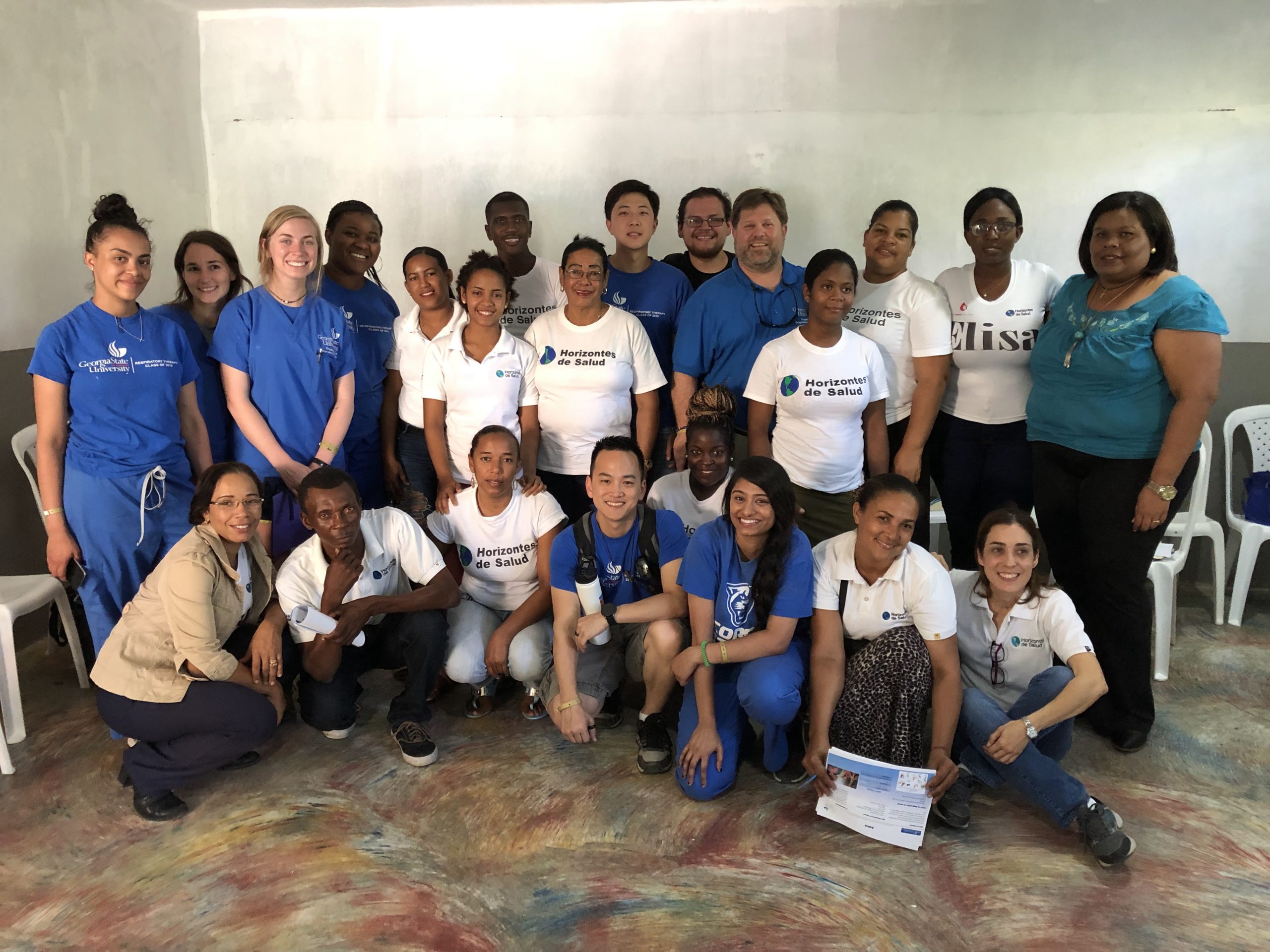 Dr. Gardenhire, fifth from the right in the back, with his GSU students and community health educators in the Dominican Republic. Students provided handouts on COPD, asthma, and carbon monoxide poisoning.
Dr. Gardenhire, fifth from the right in the back, with his GSU students and community health educators in the Dominican Republic. Students provided handouts on COPD, asthma, and carbon monoxide poisoning.“We all know the RRT is the standard of excellence,” he said. “Others around the world understand this fact, and our programs at GSU allow that access.”
However, one of his greatest passions at GSU has taken the form of study abroad programs for his students in Nicaragua and the Dominican Republic. Through these programs, he not only helped to provide medical care but also conducted studies related to the respiratory risks imposed by everyday living in those countries.
Those efforts grew out of a new strategic plan implemented at GSU that called for growth internationally.
“I was able to see for myself what indoor cooking with non-ventilated stoves and ovens was doing to residents,” he said.
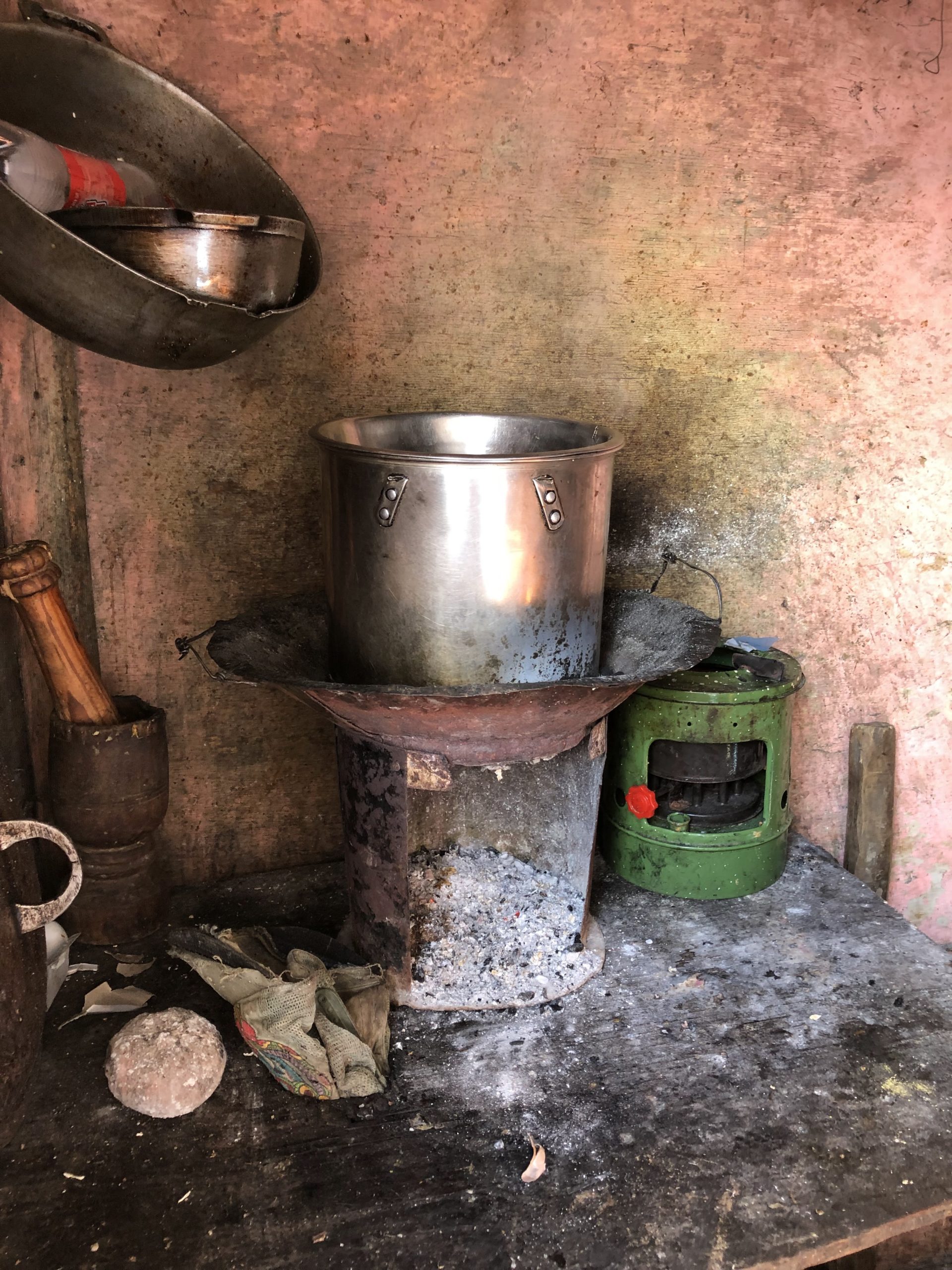 This is an example of the type of indoor, unvented cooking stoves using wood and charcoal that Dr. Gardenhire and his students found during their study abroad programs in South America.
This is an example of the type of indoor, unvented cooking stoves using wood and charcoal that Dr. Gardenhire and his students found during their study abroad programs in South America.“I was gaining more involvement with our Office of International Initiative from my work in bringing students to the MS RT program at GSU,” he explained. “Several colleagues in our college did a scouting trip to Nicaragua. They were able to see what was occurring in the rural northern coffee region outside Jinotega.”
A GSU alumni from the School of Social Work, Jon Thompson, had started a nonprofit called Comunidad Connect to help people in Nicaragua. Dr. Gardenhire joined him for the organization’s annual health summit. The experience was eye-opening.
The following year, he brought a group of his students with him to the country, and they collected data on smoking, stove and oven use, and carbon monoxide levels. They also rebuilt stoves and ovens so that they would have pipes to the outside, along with concrete floors in homes that had previously had only dirt floors.
They traveled to clinics throughout the area to see how breathing difficulties were being addressed and determine how they could foster assistance. They translated their findings into several abstracts presented during the Open Forum at the AARC Congress.
“In terms of significant studies, I cannot say which ones were most significant. However, I am most proud of our work in Nicaragua and the Dominican Republic as we worked to reduce smoke and carbon monoxide in homes by creating vented indoor cooking stoves,” he said.
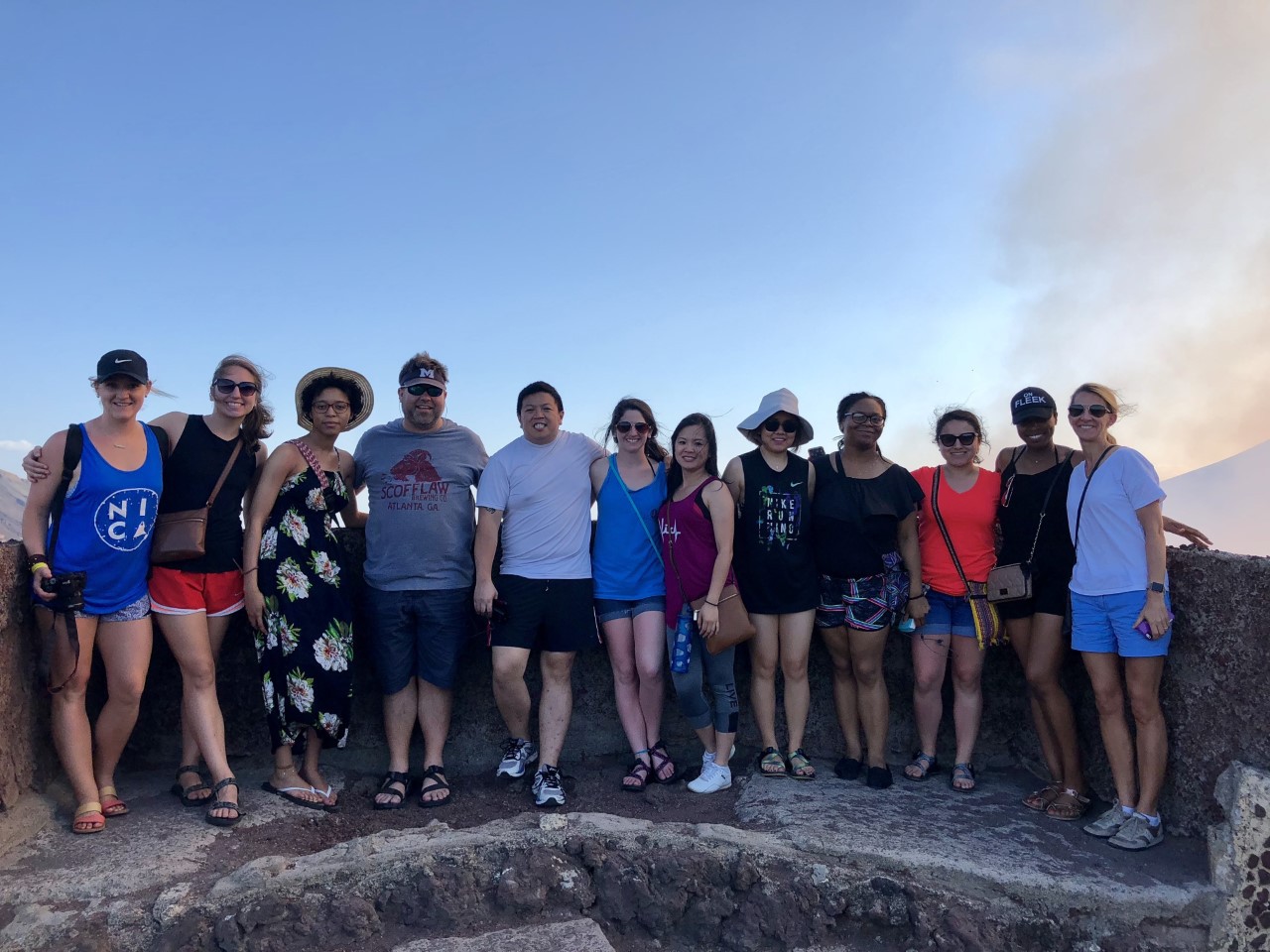 Dr. Gardenhire, fourth from the left, joined his GSU students on a visit to the Masaya Volcano outside Managua, Nicaragua, during one of their study abroad trips.
Dr. Gardenhire, fourth from the left, joined his GSU students on a visit to the Masaya Volcano outside Managua, Nicaragua, during one of their study abroad trips.When things began to improve in Nicaragua, they turned their attention to the Dominican Republic and essentially delivered the same services there. “Due to COVID, we have not traveled for the last several years, but plan to be back in the DR this spring,” said Dr. Gardenhire.
Service is important
Doug Gardenhire has been an active volunteer for the AARC and other RT-related groups and organizations throughout his career.
“To me, service is very important,” he said. “My mindset has always been to do what you can, so there have not been many times I have said no. The key is to network and ask what can be done.”
In addition to giving of his time to speak at the AARC Congress and other state and local events, Dr. Gardenhire is the co-author of the AARC’s “A Guide to Aerosol Delivery Devices for Respiratory Therapists.” He also serves on the editorial board for Respiratory Care and the Education Section’s Respiratory Care Education Annual.
Dr. Gardenhire has served the Coalition for Baccalaureate & Graduate Respiratory Therapy Education in many capacities over the years as well, and has been a member of the American Respiratory Care Foundation Review Committee since 2007. He has served as a member of the AARC Abstract Review Committee since 2004.
He was named Educator of the Year by the AARC Education Section in 2012 and became a Fellow of the American Association for Respiratory Care in 2012.
In 2020, he was selected as a Lambda Beta Honorary Life Member for his contributions to the profession.
Aside from these AARC-related posts, Dr. Gardenhire serves on the editorial board for the Internet Journal of Allied Health and Practice and is a regular reviewer for Heart and Lung. In addition, his involvement in product testing has garnered nearly $50,000 in external funding for GSU, and he regularly provides consulting and advisory services to respiratory care manufacturers and has served as an expert legal witness in cases involving respiratory issues.
Expressing thanks
When he received the call telling him he was to be the 2022 Jimmy A. Young Medalist, Dr. Gardenhire says it was “out of the blue” and came as a total surprise.
“After hanging up, honestly, I was a bit emotional and told my colleague Brent Murray that I was selected,” he said. But it didn’t take long for his instincts to kick in, and soon he was picking the phone back up to express his gratitude to those he feels are most responsible for his success in the profession.
“I was numb for just a minute. Moments later, I called Dr. Joe Rau and thanked him first for hiring me and, of course, for all the mentoring in research, aerosol medicine, and pharmacology,” he said. “Then I called Dr. Lynda Goodfellow and expressed to her how thankful I was to have her as a mentor, colleague, and friend.”
They were both overjoyed to hear the news. Said Dr. Goodfellow, “It has been a pleasure to see Doug grow and develop professionally over the past 20-plus years and receive the Jimmy A. Young Medal. This is a great accomplishment.”
Email newsroom@aarc.org with questions or comments, we’d love to hear from you.








